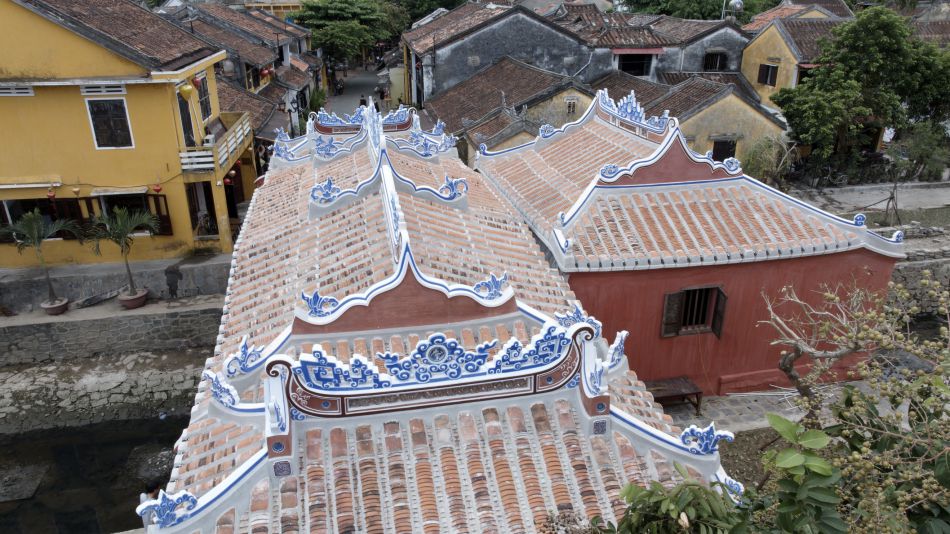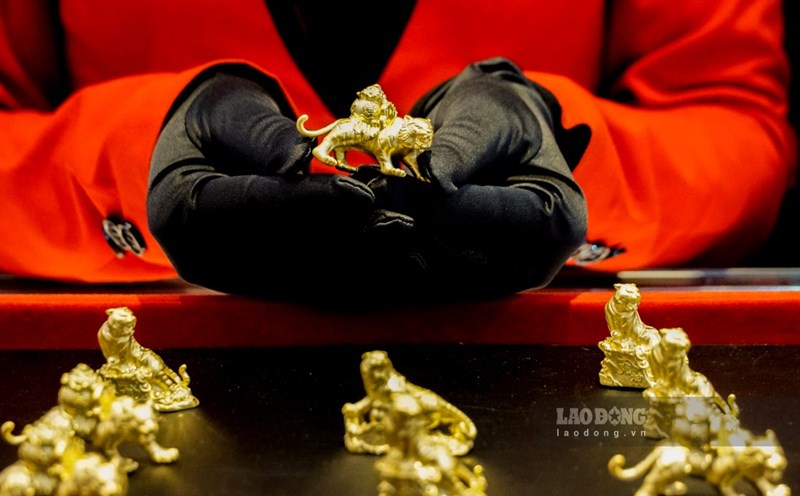Unlike some opposing opinions, I think that the restoration and embellishment of Covered Bridge has applied conservation principles to ensure the authenticity and cultural value of the monument, and is even considered a model. for the restoration and embellishment of monuments in Vietnam.
The necessity of the restoration plan is lower
Covered Bridge is not only a simple bridge but also a cultural and historical symbol of Hoi An. In 1990, Covered Bridge was recognized by the Ministry of Culture, Sports and Tourism as a national historical-cultural relic. In 1999, UNESCO named Hoi An on the list of World Cultural Heritage, with Covered Bridge as one of the important relics. The image of the Covered Bridge is also printed on the 20,000 VND banknote, demonstrating the cultural and historical value of this work in the hearts of Vietnamese people.
After more than 400 years of existence, Covered Bridge has been seriously degraded due to the effects of harsh weather, storms, and floods. According to many documents, from the time it was built to the end of the 20th century, Covered Bridge went through at least 7 renovations in the years: 1763, 1817, 1875, 1915, 1962, 1986, and 1996. However, due to Due to technical limitations and many other objective factors, recent renovations have not completely resolved the causes leading to the deterioration of the monument. Therefore, the issue of repairing Cau Pagoda continues to arise and becomes increasingly urgent.
Covered Bridge, also known as Lai Vien Kieu, is one of the prominent cultural symbols of Hoi An ancient town, Quang Nam province. Built in the mid-seventeenth century, Covered Bridge is not only a unique architectural work of art but also an important part of the World Cultural Heritage recognized by UNESCO.
On July 24, 1999, the Cau Pagoda Restoration Consulting Conference was held with the participation of many experts in researching and preserving domestic architectural heritage . Over the next decade, contents related to the renovation of Cau Pagoda were continuously discussed and discussed. However, due to concerns that the renovation will lose the ancient appearance of the Covered Bridge, and because the most suitable solution for preserving a building as symbolic and of unique value as the Covered Bridge has not been found, , the renovation only stops at the level of reinforcement and support to avoid the risk of the monument collapsing.
In the process of preparing for the restoration work, as a World Cultural Heritage, the Hoi An Cultural Heritage Management and Conservation Center, the unit assigned by Hoi An City to restore and embellish Covered Bridge, has consult experts, carefully study the 1931 Athens Charter on the Restoration of Historical Buildings; Venice Charter of 1964 for the Conservation and Restoration of Monuments and Sites. At the same time, as a symbolic relic of the relationship between Vietnam and Japan, during the restoration of the Covered Bridge relic, this relic received the help of Japanese experts from the International Cooperation Agency. Japan International Cooperation Agency (JICA) in a thorough study of the 1994 Nara Document on the Authenticity and Principles of Preservation of Historic Wooden Architecture in 1999, in which Japan is the world's leading country in duplicating Restoring wooden structures has helped Hoi An Cultural Heritage Management and Conservation Center have a scientific roadmap in restoring Cau Pagoda.
First, when starting the Cau Pagoda restoration project, the team of experts conducted a detailed survey to determine which parts of the Covered Bridge need to be preserved, repaired or replaced. Surveying is not just a surface inspection but also includes analysis of factors such as construction materials, construction techniques, and environmental factors affecting the project. To agree on a restoration plan, on August 16, 2016, an international conference on restoration of Cau Pagoda took place on a large scale, with the participation of many leading scientists and experts on relic restoration. domestic and Japanese wooden architecture. Choosing the "low level restoration" option is very necessary in the context of the Cau Pagoda being seriously degraded. The foundations are sinking and tilting; Many wooden structures are termite-ridden and rotten; The brick wall system is peeling off... causing the entire Covered Bridge to be deformed, even threatening the collapse of the building.
This option allows dismantling severely damaged parts, thoroughly handling deterioration issues for reinforcement and replacement, while still retaining usable original elements. If the "partial renovation" option is chosen, these problems will not be completely resolved, as happened in the previous 6 restorations. Choosing the right option is very important to ensure the sustainability of the project.
On December 28, 2022, the renovation of Covered Bridge took place with great determination from the project implementation team, hoping that the renovation will preserve and enhance the value of the monument completely. face. This restoration was carried out with a total investment of 20.2 billion VND from the budget of Hoi An City and Quang Nam province. The main goal of the restoration is to restore the appearance of the Covered Bridge, ensure the safety of the building and maintain its historical and cultural value. On the Fanpage of Hoi An Cultural Heritage Management and Conservation Center, Mr. Pham Phu Ngoc - Director of Hoi An Cultural Heritage Conservation Management Center, emphasized: "The survey, research and evaluation , technical handling... ensures that the renovation work is carried out carefully and methodically." This proves that experts have performed their work with great seriousness and responsibility.


Ensure the authenticity of the monument
During the restoration process, the dismantling of damaged parts is done carefully and scientifically, ensuring not to affect the remaining parts of the building. The restoration team uses specialized tools to remove damaged parts without damaging other parts.
According to the Nara Document on Authenticity, “Authenticity” includes design ideas, construction materials, technical technology and methods of use. Because I am a person working in the field of heritage and archeology, I have followed the process of restoring and embellishing Cau Pagoda by the real investor of Hoi An Cultural Heritage Management and Conservation Center. Currently, propaganda work is carried out through the Hoianheritage.net website, the Heritage Conservation radio section, the Hoi An Heritage Facebook page, along with connecting with press agencies to introduce and provide information. about the project. At the same time, the team also compiled and published the book "Heritage Conservation Research Information specialized on the Cau Pagoda relic" (in bilingual Vietnamese - English), produced a film introducing the value of the relic This and the direction for the renovation project.
All of these activities are aimed at soliciting opinions and providing information to specialized management agencies on cultural heritage in the country as well as international organizations. At the same time, on business trips to Hoi An, I also visited the "Pagoda Restoration Site" and learned that the implementing unit was very careful and meticulous in this process, even numbering the management. each wooden structure, brick... when dismantling.
After dismantling, the foundations and wooden structures will be reinforced to increase durability and ensure the safety of the project. Experts also re-examined the condition of the remaining parts to determine that they were still safe and usable. Along with this process, one of the most important principles is to preserve the original elements of the building, including retaining pattern details, damaged wood and tiles, and replacing them with materials. Similar data to ensure authenticity. During the restoration process, the authenticity of the monument was strictly followed by the Cau Pagoda restoration team.
Mr. Pham Phu Ngoc - Director of Hoi An Cultural Heritage Conservation Center, informed about Covered Bridge: "Nearly 60% of the volume of wood, 30% of the tiles, 80% of the ancient plates, 20% of the stone structures The foundation and 35% of the ornamental animals on the roof have been preserved and repositioned at the monument after renovation." This shows that the Cau Pagoda restoration team has effectively carried out the processes and retained the maximum appearance of the monument.
In addition, during the restoration process, inviting experts from Japan, especially from the JICA Organization, helped the Cau Pagoda construction unit apply advanced techniques and experience from developed countries. , ensuring high accuracy during the restoration process. Japanese experts have provided effective conservation solutions, helping to improve the sustainability of the project. This also contributes to the restoration of Covered Bridge without losing its cultural identity but also highlighting the artistic values of the monument.
Although there have been many positive opinions about the restoration of Cau Pagoda, there is no shortage of criticism from the community. Many people believe that the Covered Bridge has been "rejuvenated" and that the restoration has ruined a "symbol of Hoi An". The color of the roof decoration system of the Covered Bridge has been repaired and restored based on locations that still retain their original color status, combined with research and surveys of similar traditional religious works in Hoi An. Follow the recommendations of experts through consultations and discussions. Although color restoration can make a monument look "newer", what is important is that the originality has been preserved, following the principle of restoration appropriate to the nature of the monument. Over time, Covered Bridge will gradually return to its ancient and quiet features like in history after restorations, as well as during the annual offerings, festivals and Tet holidays.
Article 9 of the 1964 Venice Charter on the Conservation and Restoration of Monuments and Sites states: “The restoration process is a highly specialized operation. The purpose of restoration is to preserve and highlight the aesthetic and historical value of the monument, which must be based on respect for original materials and authentic evidence. Restoration must stop as soon as there is speculation, and if additional work is necessary for aesthetic or technical reasons, the addition must be clearly distinguishable from the architectural layout and dated at the time of execution. . In all cases, before and after restoration there must be archaeological and historical research."
The restoration of Covered Bridge is not only an act of conservation but also an important step in preserving the cultural heritage of humanity. In fact, this work has been restored strictly, scientifically and with enthusiasm. The seemingly new colors of the Covered Bridge after restoration will "sink" after just a few rainy and sunny seasons, but what is important are the core values of the Covered Bridge in terms of history, culture, art and values. Emotional value and long-term use value still exist with the community and country. In addition, the restoration process was also recorded and researched systematically to prepare for the process of publishing books to mark and transmit to the next generation how to use the traditional methods of our ancestors. , combined with advanced Japanese methods in the process of restoring Cau Pagoda.
So, is there anything worth "stirring" about Cau Pagoda after restoration? We should see this as a success in preserving and promoting the cultural value of historical relics in Vietnam. Prof.Dr. Lam Thi My Dung - former Head of the Department of Archeology, Faculty of History, University of Social Sciences and Humanities, Hanoi National University once affirmed that: "Restoration of Cau Pagoda was carried out in a methodically and scientifically and can be a reference lesson for other archaeological heritage restorations, especially living heritages such as Covered Bridge."
Preserving and restoring monuments is an interdisciplinary science: Construction, history, architecture, art. Restoration work must be based on comprehensive research, surveys, analysis and evaluation. The process of restoring the Cau Pagoda relic is carried out in many steps:
- Inventory and prepare relic records.
- Minimize interference with the monument, any unnecessary intervention that reduces or changes the basic characteristics and inherent values of the monument.
- Recovery must be based on genuine grounds, absolutely not made on assumptions.
- Prioritize the use of similar materials, materials and traditional construction processes and techniques. The use of new materials and techniques when necessary requires solutions that do not affect the inherent characteristics and values of the monument.
- Supervise, train, and publish publications.











